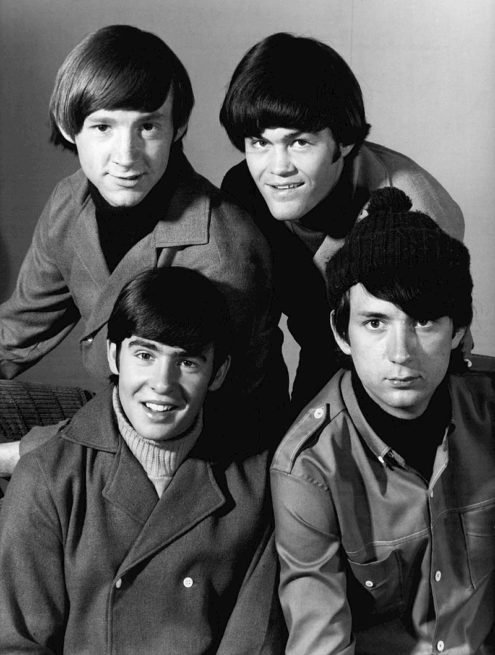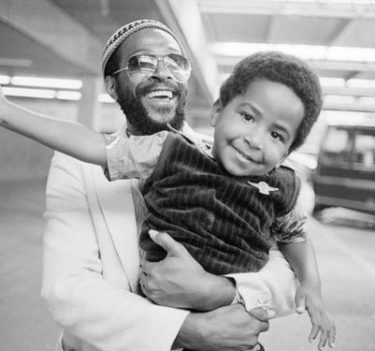1960s men’s haircuts and hairstyles encompass two opposite extremes and just about everything in between. On one end is the classic well groomed sidepart, and on the other is the new long haired, bearded protester. Men’s hair in the 1960s saw focused attention for the first time in the 20th century, and with its freedom came rapid change and experimental looks. A lot came and went in ten years on a backdrop of the more default hairstyles. In this article, we’ll be going over the fresher and more period-defining haircuts and trends of the 1960s decade.
1960s Men’s Hairstyles
The Businessman’s Standard
Men’s hairstyle trends of the 1940s held steady through the 1950s and even into the 1960s. They did not, however, leave the ’60s unscathed. The sleek business side part grew longer, shaggier, and bangs began to fall into a man’s face. The rugged and slightly overgrown look was a preview as to what was to come.

Anthony Perkins in a promotional image for Five Miles to Midnight (1962)
Unlike in the 1950s, where the professional man had nary a hair out of place, the 1960s office man was being exposed to a growing undercurrent of creativity and self expression. Advertisement agencies were teetering towards a boom and now more than ever before, presentation standards shifted gear. Towards the end of the 1960s, many employers were looking for employees that stood out from the old ’50s standard — if the copywriter didn’t dress oddly or have long hair, was he really the creative type they needed to succeed? This sudden shift in business expectations in advertisement in particular was excellently detailed in the book The Conquest of Cool.
More surprising still is the speed at which change happened. Men’s fashion has been historically slow to evolve, but there was nearly year-to-year change in men’s hair in the 1960s, even among budding professionals. You can view an album of 1960-1969 Durham University graduates here as example. Notice how quickly hair began to grow past the ears, and how facial hair emerged in the later half of the decade.

1966 Durham University Alumni. Note the bangs, bouffant hair, and beard. View the rest of the album here.
This went in line with other changes in men’s businesswear, from polyester suits to flared trousers. Suffice to say, the male businessman’s standard going into the 1970s was… different.
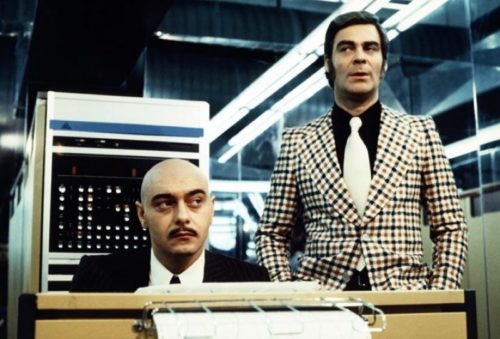
World on a Wire (1973) – the new businessman of the late ’60s and early ’70s.
Pompadours, Ducktails, and Boxcars
Rebels, greasers, ton-up boys, and all the shook-up kids from the 1950s introduced quiffs, ducktails, flat tops, and pompadours into rebel and youth culture. From there, both the kids and the hairstyles grew into the 1960s, where they took off with more than just teenagers. As these hairstyles developed further into the 1960s, they grew longer, more pronounced, and often more exaggerated. Sideburns continued to creep further and further down the face, too, but we’ll talk more about that later.

Johnny Cash in 1968
1960s men’s pompadours required long hair that was heavily sculpted with products ranging from oil to petroleum jelly. Hair was pulled tightly back at the sides and teased up at the top, either back for the classic pompadour or out from the forehead for a ducktail. Those who kept shorter hair could follow the same heavily styled credo with a more militaristic flat top or a boxcar haircut.
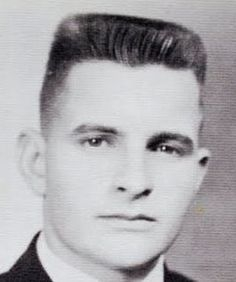
1960s Flat Top
While celebrities and icons wore their hair big, it was still most popular with youth or those with a message. A series of sketches in Tom Wolfe’s essay novel The Kandy Kolored Tangerine Flake Streamline Baby provides an excellent and humorous look into the transitional period of the early 1960s among younger men:
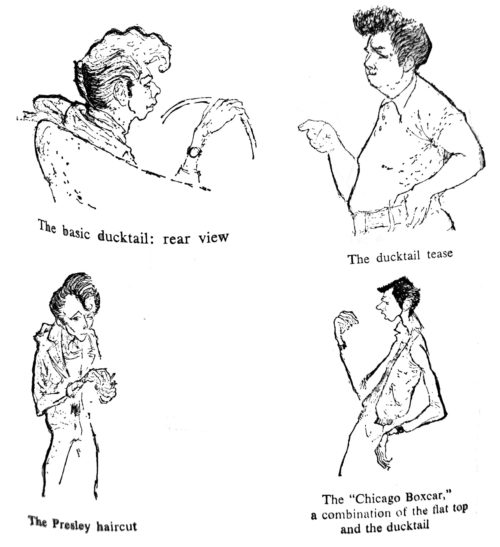
Mod Bowl Cuts, Arthurs, and Mop Tops
Spearheaded by The Beatles in the earlier half of the 1960s, they had coined the name “Arthur” for this hair style. Obviously, the name didn’t stick. It did, however, take off. If there was any emerging boy band in the 1960s whose name structure was “The” followed by an animal name, then this was almost every band member’s haircut.
- The Monkees, 1966
Mop tops began in the early 1960s with nearly trimmed longer hair that parted down the middle. In a schoolboy fashion, this bowl-shaped haircut covered the tops of the ears and went down to at least mid-forehead in the front. It did not go lower than halfway down the neck for a few years past its inception. The mop top was also swept up in 1960s hair trends, and eventually the baseline cut grew longer and shaggier.
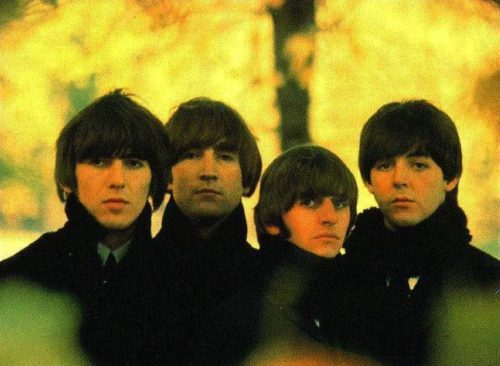
Mop Tops with some shag
Into the early 1970s, it wasn’t uncommon to see mop tops grown out to the shoulders with bangs that went past the browline. Both these and their shorter predecessors were commonly accompanied with long sideburns that crept further and further down the face.
1960s Hippie Longhairs
It’s hard to believe it now, but in the 1960s, long hair on a man was an extreme statement — and an unacceptable one. It went so hard against the grain that it frightened many, and coupled with the general politics of hippies as they revolutionized the late 1960s, long hair became a symbol many Americans looked down upon. This pushback was obviously futile, but it proved just how much and how quickly things were changing in the 1960s.
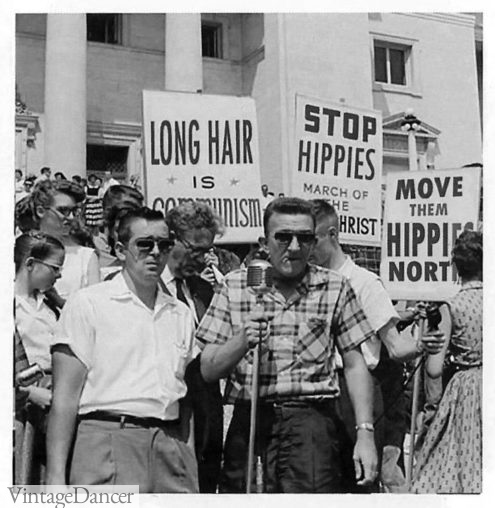
So what did this revolutionary haircut look like? Well, there was no real standard. Matter of fact, it was a deliberate lack of care for style that brought it out. Hair was simply grown out without much rhyme or reason or grooming. While you could say hair was generally center-parted with no bangs, there was no standard from which the majority people drew inspiration.
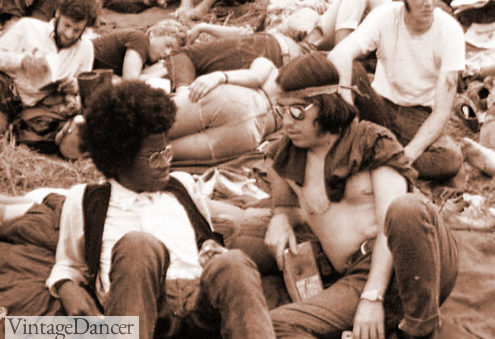
A pair of hippies at Woodstock
Hair was not the only thing that was being grown out, however. Often in line with long Jesus hair came the advent of beards.
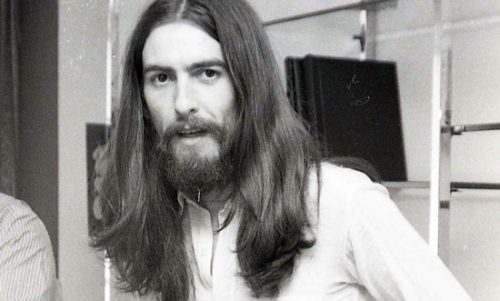
George Harrison with his hair at its longest, early 1970s
1960s Black Men’s Hairstyles
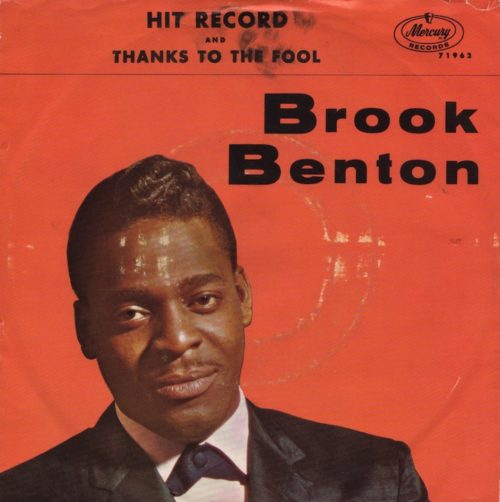
Brook Benton’s 1962 Vinyl cover – conk with a wave
Throughout the early 20th century, African American men’s natural hair texture was rarely shown. If he did not keep his hair closely cut, he often wore a “conk” – a hairstyle that involved chemically straightening his hair with lye. The conk was an incredibly high maintenance hairstyle, requiring constant attention, restyling, heavy use of products, and regular retreating of hair as it grew out. Even into the early 1960s, many men still wore their hair conked and conservatively groomed into either a pompadour, slight wave, or slicked back.
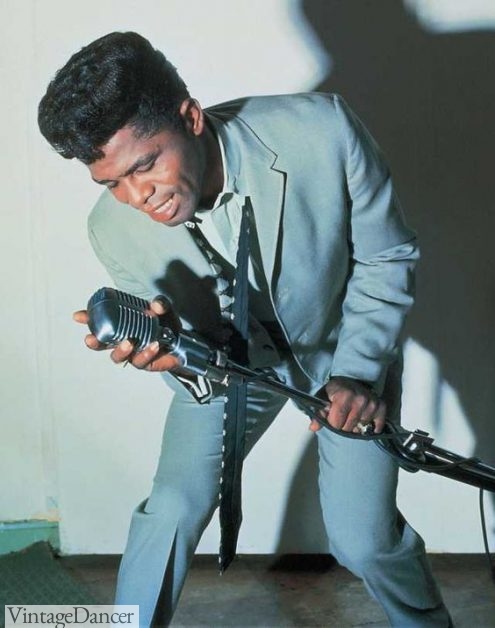
1960 James Brown wears a robins egg blue suit with conked hair
Things took a massive change around the mid 1960s, in line with the growing influence of the Black is Beautiful movement.
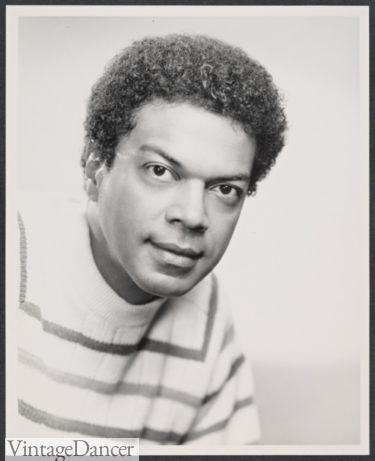
1960 Charles Bettis – Fuller hair leading to the Afro
Perhaps most notorious of all 1960s hairstyles is the Afro. The afro was a combination of natural hair texture and aesthetic inclinations. While the afro existed before the 1960s, it saw an explosion of popularity this decade and became a keystone hairstyle of individuality, self expression, and pride in one’s heritage.
Both men and women wore afros – provided they had the patience to grow their hair out and the time to keep it well groomed and in proper shape. Towards the later 1960s, afros were popular and fashionable to the point that afro wigs were a popular purchase, though they were more common with women.
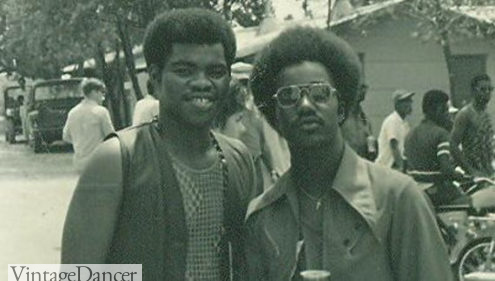
Short natural (left) and more rounded afro (right)
- Marvin Gaye and Son – note the beard
Shorter variations of the afro also existed. Also called “short naturals,” these used a man’s natural hair texture with significantly less grooming involved. While some remained rounded like the afro, others followed the contours of the head — they were short on the sides, higher up top, and required significantly less grooming to keep the circular shape of the afro. Short naturals became a sanctioned haircut in the US military in 1969.
Dreadlocks were another black men’s hairstyle that appeared in 1960s pop culture, worn by Bob Marley in 1967. They became far more popular in the 1970s.
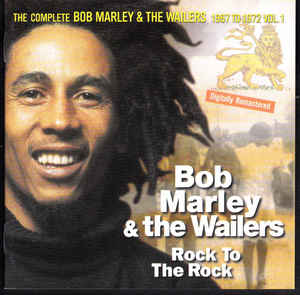
Bob Marley and the Wailers
1960s Men’s Facial Hair and Beards
As it were, you weren’t cool in the 1960s college scene if you weren’t growing some sort of facial hair. Beatniks arguably began the mid-century trend of counterculture intellectualism in the form of a beard, but the hippies and “creatives” are the ones we should credit for beards being accepted in the office and on the street.
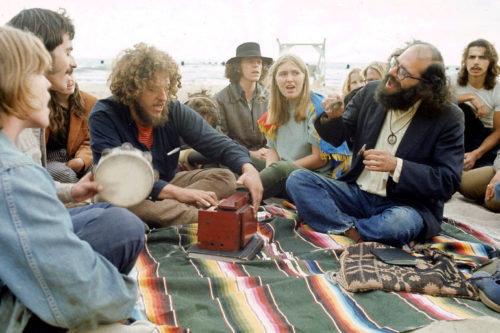
Allen Ginsberg sings to a group of hippies in 1968 – note the beards and the hair!
That’s not to say, however, that they were the ones at the source of its inception. Facial hair in popular culture most likely evolved from the increasingly exaggerated sideburns seen not only on pompadours and jelly rolls but also in Mod culture’s mop tops and pageboys. These were sharp and edgy, celebrated even as they crept further down the face.
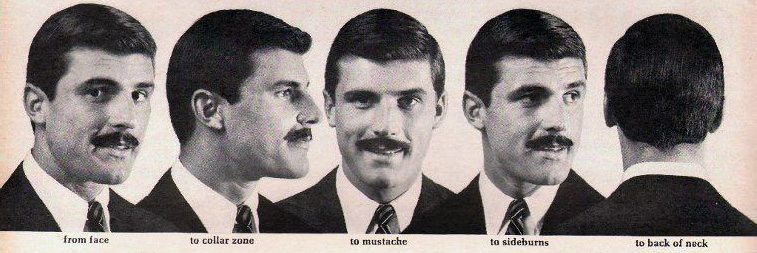
1965 mustache
From there, mustaches became the fashionable item. These mustaches were typically left bushy on the upper lip, but could creep down to form handlebars. The Beatles were seen with mustaches for quite some time. Around the same time, there was also the faint anchor beard and goatee, both made by growing hair out at the chin and occasionally further up the jaw.
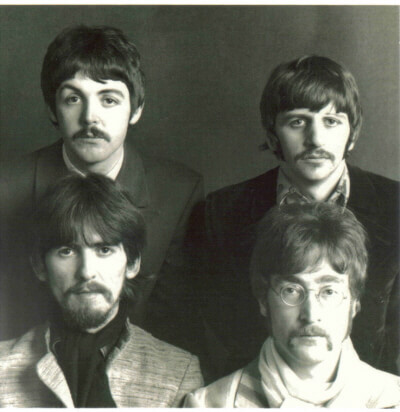
The Beatles in 1967
This gave the full beard the opportunity and stage to appear and remain. Many 1960s facial hair styles are back in style today, but the 60s style mustache has the most vintage appeal and is seen the least.
Looking back, the 1960s are considered something of a blunder for men’s hair and facial hair — mop tops look quite silly to modern sensibilities, and so do the affectionately named “pornstaches” and “Jesus hair” seen so often in 1960s family photos. Were it not for this legendary transitional period, however, then the scene of men’s facial hair and hairstyls may have never left their early 20th century rut.
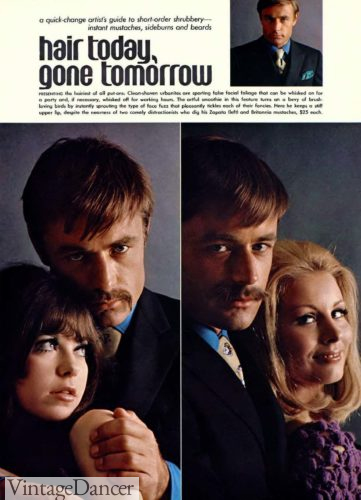
1968 fake mustaches
Read More:
- 1940s Men’s Hairstyles
- 1950s Men’s Hairstyles and Grooming
- 1960s Men’s Fashion Overview
- Hippie History and Fashion
- 1960s Men’s Outfit Ideas
